tsunami

 These days, we have early warning alarms for tornadoes, floods, hurricanes, and even tsunamis, but on July 21, 365, no such warnings existed, not did any kind of measuring tools so we could know the magnitude of the earthquake that caused tsunamis, or the height of the tsunami itself. Nevertheless, it is known that a powerful earthquake off the coast of Greece caused a tsunami that devastated the city of Alexandria, Egypt.
These days, we have early warning alarms for tornadoes, floods, hurricanes, and even tsunamis, but on July 21, 365, no such warnings existed, not did any kind of measuring tools so we could know the magnitude of the earthquake that caused tsunamis, or the height of the tsunami itself. Nevertheless, it is known that a powerful earthquake off the coast of Greece caused a tsunami that devastated the city of Alexandria, Egypt.
In spite of the lack of measuring tools at the time, scientists can now estimate that the earthquake was actually two quakes in quick succession. It is estimated that the largest of those quakes was about a magnitude of 8.0. That magnitude of quake is massive by any standards, and it must have been very scary for anyone who might have felt it. It’s hard to say how many people actually felt it, because of its oceanic location, but even if no one felt the quake, they very much felt the aftereffects of that quake. The really tragic thing was that they had no idea what was coming their way, how very dangerous it was, or even that they should run when they saw it coming. I’m sure that they had seen tides come in and go out, and even storms bringing big wave onto the shore. So, it is very possible that they thought this was not that different than those things, except for it not being time for the tide and there was no storm. They likely just stood there looking at this strange phenomenon, until it took them all out.
The quake was centered near a plate boundary called the Hellenic Arc. Following the quake, a wall of water ran across the Mediterranean Sea toward the Egyptian coast. As happens in tsunamis, the water first recedes, and then comes crashing back. As the water in the harbor receded, ships docked at Alexandria suddenly overturned. As often happens in a disaster, it was reported that many people rushed out to loot the overturned ships. That put even more people in harm’s way. The tsunami wave then rushed in and carried the ships over the sea walls, landing many on top of buildings. The people were trapped, and in Alexandria alone, on that one day, approximately 5,000 people lost their lives, and 50,000 homes were destroyed.
The destruction was even greater in the surrounding villages and towns. Many of these small villages were literally wiped of the face of the earth. Outside of Alexandria, 45,000 people were killed. The salty sea water, inundation the farmlands, rendering them useless for years. From what scientists are able to piece together, the area’s shoreline was permanently changed by the disaster. The tsunami continued on, slowly, but steadily 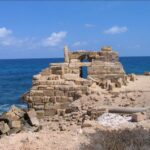
 overtaking the buildings of Alexandria’s Royal Quarter. The main reason that the archaeologists learned about this horrific event was that in 1995 that archaeologists actually discovered the ruins of the old city, which lies off the coast of present-day Alexandria. With the changed shoreline following the tsunami, many of the old buildings remained under water for centuries.
overtaking the buildings of Alexandria’s Royal Quarter. The main reason that the archaeologists learned about this horrific event was that in 1995 that archaeologists actually discovered the ruins of the old city, which lies off the coast of present-day Alexandria. With the changed shoreline following the tsunami, many of the old buildings remained under water for centuries.
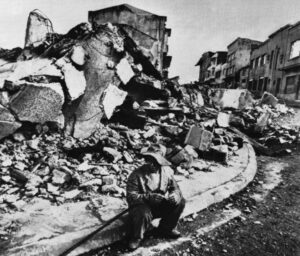
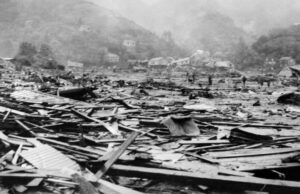 I would never have considered that an earthquake in Chili could affect Hawaii, which is 6,593 miles away, but on May 23, 1960, that seemingly huge distance suddenly became very small. When a 9.5 magnitude earthquake hit Chili on May 22, 1960, thousands of people lost their lives, and a giant tsunami was triggered. By the next day, that tsunami had traveled across the Pacific Ocean and killed an additional 61 people in Hilo, Hawaii. That distance and the amount of devastation seems incredible to me.
I would never have considered that an earthquake in Chili could affect Hawaii, which is 6,593 miles away, but on May 23, 1960, that seemingly huge distance suddenly became very small. When a 9.5 magnitude earthquake hit Chili on May 22, 1960, thousands of people lost their lives, and a giant tsunami was triggered. By the next day, that tsunami had traveled across the Pacific Ocean and killed an additional 61 people in Hilo, Hawaii. That distance and the amount of devastation seems incredible to me.
The earthquake, which involved a severe plate shift, caused a large displacement of water just off the coast of southern Chile at 3:11pm. The resulting wave, traveling at speeds in excess of 400 miles per hour, moved west and north. The damage to the west coast of the United States was estimated at $1 million, but there were no deaths there.
In 1948, the Pacific Tsunami Warning System was established in response to another deadly tsunami. It worked properly and warnings were issued to Hawaiians six hours before the deadly wave was expected to arrive. Unfortunately, some people ignored the warnings, as always seems to happen. Some other people actually headed to the coast in order to view the wave…like the warning was actually an announcement of a coming attraction. The tsunami arrived only a minute after it was predicted, and it absolutely destroyed Hilo Bay on the island of Hawaii.
People really don’t fully understand just how much destructive power water has, until they see it in action. When the waves hit Hilo Bay, they were thirty-five-feet high. They were so strong that they bent parking meters to the ground and wiped away most of the buildings. When the wave hit a 10-ton tractor, it was swept out to sea like it was made of Styrofoam. you would think that boulders would be sturdy enough to hold back the waves, but the 20-ton boulders that made up the seawall were easily moved 500 feet. The 61 people who lost their lives were in Hilo…the hardest hit area of the island chain.
With all of that destruction, you might be inclined to think that the waves would have lost power, and to a degree, I suppose they did. Nevertheless, the tsunami continued to race further west across the Pacific. Even given a ten-thousand-mile distance from the earthquake’s epicenter, Japan still wasn’t able to provide enough warning time to get the people out of harm’s way. The wave hit Japan at about 6:00pm, more than a full day after the earthquake. The tsunami struck the Japanese islands of Honshu and Hokkaido. The wave’s power was still enough to crushing 180 people, and to leave 50,000 more homeless. In Japan, it caused $400 million in 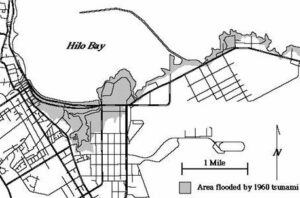
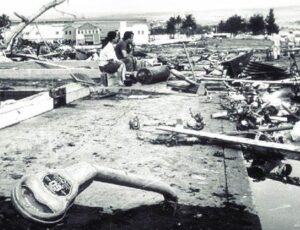 damages. With everything destroyed by this one earthquake and the subsequent tsunami, you would think that people would finally learn to stay away from the shore during a tsunami warning, but every year people lose their lives because they decided to cross paths with waves…be it from tsunamis, hurricanes, and other floods. Water is a force to be reckoned with. It should be considered very dangerous.
damages. With everything destroyed by this one earthquake and the subsequent tsunami, you would think that people would finally learn to stay away from the shore during a tsunami warning, but every year people lose their lives because they decided to cross paths with waves…be it from tsunamis, hurricanes, and other floods. Water is a force to be reckoned with. It should be considered very dangerous.
 Volcanoes don’t just suddenly start erupting without warning. There is always some kind of warning. Things like earthquake swarms, a bulging mountain side, and little smoke and ash showings from the crater, always come first. These may not always all happen, but they do happen. The biggest problem in 1883 is that scientists didn’t really know that then. When Krakatoa, in the Sunda Strait of Indonesia, began to wake up on May 20, 1883, it had been dormant for around 200 years. The first sign was an ash cloud that was reported by the captain of a German warship. It rose nearly 7 miles above the island. Strangely, no one in Anjer, 25 miles from the island, or Merak, 35 miles away, reported anything unusual that day, but the inhabitants of Batvia, 80 miles away, “were startled by a dull booming noise, followed by a violent rattling of doors and windows. Whether this proceeded from the air or from below was a matter of doubt, for unlike most earthquake shocks the quivering was only vertical.” The event started rumblings and blasts from the volcano’s vents that continued for the next three months. But this was just the beginning.
Volcanoes don’t just suddenly start erupting without warning. There is always some kind of warning. Things like earthquake swarms, a bulging mountain side, and little smoke and ash showings from the crater, always come first. These may not always all happen, but they do happen. The biggest problem in 1883 is that scientists didn’t really know that then. When Krakatoa, in the Sunda Strait of Indonesia, began to wake up on May 20, 1883, it had been dormant for around 200 years. The first sign was an ash cloud that was reported by the captain of a German warship. It rose nearly 7 miles above the island. Strangely, no one in Anjer, 25 miles from the island, or Merak, 35 miles away, reported anything unusual that day, but the inhabitants of Batvia, 80 miles away, “were startled by a dull booming noise, followed by a violent rattling of doors and windows. Whether this proceeded from the air or from below was a matter of doubt, for unlike most earthquake shocks the quivering was only vertical.” The event started rumblings and blasts from the volcano’s vents that continued for the next three months. But this was just the beginning.
Krakatoa began to erupt in earnest on the afternoon of August 26, 1883, sending ash clouds at 22 miles above the island. Along with the eruption came a tsunami that rolled up both sides of the strait. The eruption continued into the night with increasing violence, and at midnight by volcanic lightning strikes to distances of ten to twelve miles. The event was similar to a horror movie, complete with electrical phenomena to a terrifying scale. The glow that surrounded the gigantic column of smoke and ashes was seen in Batava, eighty miles away. Some of the debris fell as fine ashes in Cheribon, five hundred miles east of the volcano.
While the August 26th event was terrifying, the most terrifying part of the disaster happened the next day. When Krakatoa erupted on August 27, the sound it made was accompanied by pressure waves that ruptured the eardrums of people 40 miles away, traveled around the world four times, and was clearly heard 3,000 miles away. That distance is comparable to the distance between New York and und from San Francisco. The 1883 eruption of Krakatoa was one of the deadliest and most destructive volcanic events in recorded history. Explosions were so violent that they were heard 1,930 miles away in Perth, Western Australia, and 3,000 miles  away in Rodrigues near Mauritius. At least 36,417 deaths were attributed to the eruption and the tsunamis it created. The sound was claimed to be heard in 50 different locations around the world and the sound wave is recorded to have travelled the globe seven times over. Following the eruption, there were increased seismic activity that continued until February 1884, although there is speculation as to whether on not that was because of Krakatoa. Whether it was or not, really makes no difference, because the effects that can be confirmes as part of the aftermath of Krakatoa are big enough on their own. The 1883 eruption of Krakatoa was a major event, and possibly the biggest on in recorded history.
away in Rodrigues near Mauritius. At least 36,417 deaths were attributed to the eruption and the tsunamis it created. The sound was claimed to be heard in 50 different locations around the world and the sound wave is recorded to have travelled the globe seven times over. Following the eruption, there were increased seismic activity that continued until February 1884, although there is speculation as to whether on not that was because of Krakatoa. Whether it was or not, really makes no difference, because the effects that can be confirmes as part of the aftermath of Krakatoa are big enough on their own. The 1883 eruption of Krakatoa was a major event, and possibly the biggest on in recorded history.
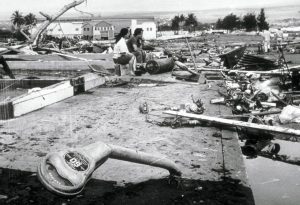 These days, scientist and inventors have collaborated to develop early warning systems for just about any possible disaster, and when everything works as it should, and people heed the warnings, loss of life can often be avoided. Having the technology is great, but technology can’t make human beings do the right things…unfortunately. On May 22, 1960, twelve years after tsunami warnings were developed, and with the warning system in good working order, a massive 9.5 earthquake struck off the coast of Chili. It was the largest earthquake ever recorded. Unfortunately, we don’t really have an earthquake warning, and so without warning, 1655 people lost their lives in Chili and 3,000 injured in the quake. Two million people were made homeless, and damage was estimated at $550 million. The earthquake, involving a severe plate shift, caused a large displacement of water off the coast of southern Chile at 3:11pm. Traveling at speeds in excess of 400 miles per hour, the tsunami moved west and north. On the west coast of the United States, the waves caused an estimated $1 million in damages, but were not deadly. Everyone assumed that the worst was over.
These days, scientist and inventors have collaborated to develop early warning systems for just about any possible disaster, and when everything works as it should, and people heed the warnings, loss of life can often be avoided. Having the technology is great, but technology can’t make human beings do the right things…unfortunately. On May 22, 1960, twelve years after tsunami warnings were developed, and with the warning system in good working order, a massive 9.5 earthquake struck off the coast of Chili. It was the largest earthquake ever recorded. Unfortunately, we don’t really have an earthquake warning, and so without warning, 1655 people lost their lives in Chili and 3,000 injured in the quake. Two million people were made homeless, and damage was estimated at $550 million. The earthquake, involving a severe plate shift, caused a large displacement of water off the coast of southern Chile at 3:11pm. Traveling at speeds in excess of 400 miles per hour, the tsunami moved west and north. On the west coast of the United States, the waves caused an estimated $1 million in damages, but were not deadly. Everyone assumed that the worst was over. 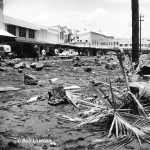
Nevertheless, warnings were sent to the Hawaiian islands. The Pacific Tsunami Warning System properly and warnings were issued to Hawaiians six hours before the wave’s expected arrival. The response of some people, however, was reckless and irresponsible. Some people ignored the warnings, and others actually headed to the coast in order to view the wave. Arriving 15 hours after the quake, only a minute after predicted, the tsunami destroyed Hilo Bay, on the island of Hawaii. Thirty five foot waves bent parking meters to the ground and wiped away most buildings, destroying or damaging more than 500 homes and businesses. A 10 ton tractor was swept out to sea. Reports indicate that the 20 ton boulders making up the sea wall were moved 500 feet. Sixty-one people died in Hilo, the worst-hit area of the island chain. Damage was estimated at $75 million. This tsunami caused little damage elsewhere in the islands, where wave heights were in the 3-17 foot range. The tsunami continued to race further west across the Pacific. Ten thousand miles away from the earthquake’s epicenter. Japan, received warning, but wasn’t able to warn the people in harm’s way. At about 6pm, more than a day after the quake, the tsunami hit the Japanese islands of Honshu and Hokkaido. The  crushing wave killed 180 people, left 50,000 more homeless and caused $400 million in damages. The Philippines, also hit, saw 32 people dead or missing.
crushing wave killed 180 people, left 50,000 more homeless and caused $400 million in damages. The Philippines, also hit, saw 32 people dead or missing.
Tsunami warnings definitely save lives, but only if people will heed the warnings. As long as people decide that the warning doesn’t apply to them, and give in to their curiosity to go have a look, there will continue to be deaths. It seems a great shame that inventors and scientist work so hard to make a warning to save lives, and then some people refuse to do what is necessary to be safe after they have been warned. I simply don’t understand how people can ignore these warnings and take a chance with their lives.

 When most of us think about April Fool’s Day, we think of playing some funny prank on our family or friends, but on April Fool’s Day 1946, the Earth played a prank, if it could be called that, on Hawaii. It was a prank that wasn’t funny, and it would claim the lives of 159 people. Early in the morning of that April Fool’s Day, a 7.4 magnitude earthquake struck in the North Pacific, 13,000 feet beneath the ocean surface, and off Unimak Island in the Aleutian chain, that makes up the tail of Alaska. The quake triggered devastating tidal waves throughout the Pacific, and particularly aimed at Hawaii. The first tidal wave hit Unimak Island shortly after the quake struck. The wave was estimated to be almost 100 feet, and it crashed into a lighthouse 30 feet above sea level. Five people lived in the lighthouse. It was smashed to pieces, and all five were killed instantly. The wave then headed toward the Southern Pacific at 500 miles per hour. The situation was like a freight train carrying an atomic bomb.
When most of us think about April Fool’s Day, we think of playing some funny prank on our family or friends, but on April Fool’s Day 1946, the Earth played a prank, if it could be called that, on Hawaii. It was a prank that wasn’t funny, and it would claim the lives of 159 people. Early in the morning of that April Fool’s Day, a 7.4 magnitude earthquake struck in the North Pacific, 13,000 feet beneath the ocean surface, and off Unimak Island in the Aleutian chain, that makes up the tail of Alaska. The quake triggered devastating tidal waves throughout the Pacific, and particularly aimed at Hawaii. The first tidal wave hit Unimak Island shortly after the quake struck. The wave was estimated to be almost 100 feet, and it crashed into a lighthouse 30 feet above sea level. Five people lived in the lighthouse. It was smashed to pieces, and all five were killed instantly. The wave then headed toward the Southern Pacific at 500 miles per hour. The situation was like a freight train carrying an atomic bomb.
Hawaii was 2,400 miles south of the quake’s epicenter, and Captain Wickland of the United States Navy was the first person to spot the coming wave at about 7:00am, four and a half hours after the quake struck in the Aleutian Islands. His position on the bridge of a ship, 46 feet above sea level, put him at eye level with a “monster wave” that he described as two miles long. The first wave came in and receded, then the water in Hilo Bay seemed to disappear. The boats that were docked there, settled on the sea floor, surrounded by flopping fish. Then…the second wave hit…and it was massive!! The city of Hilo was hit by a 32 foot wave that devastated the town. Nearly a third of the city was completely destroyed. The bridge that crossed the Wailuku River was picked up by the wave, and pushed 300 feet away. In Hilo, 96 people lost their lives in the tsunami. Other parts of Hawaii were hit even worse. In some places, the waves reached heights of 60 feet. A schoolhouse in Laupahoehoe was crushed by the tsunami, killing the teacher and 25 students inside.
The massive wave was seen as far away as Chile, where, 18 hours after the quake near Alaska, unusually large waves crashed ashore, but there were no casualties. This tsunami prompted the United States to establish the Seismic SeaWave Warning System two years later, which is now known as the Pacific Tsunami Warning System. 
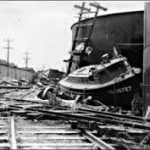 It uses undersea buoys throughout the ocean, in combination with seismic-activity detectors, to find possible killer waves. The warning system was used for the first time on November 4, 1952. That day, an evacuation was successfully carried out, but the expected wave never materialized. Still, like the fire drills we all know about from school, maybe Tsunami Drills wouldn’t be a bad thing either, especially if it would prevent the kind of loss of life that Hawaii experienced on that awful April Fool’s Day in 1946.
It uses undersea buoys throughout the ocean, in combination with seismic-activity detectors, to find possible killer waves. The warning system was used for the first time on November 4, 1952. That day, an evacuation was successfully carried out, but the expected wave never materialized. Still, like the fire drills we all know about from school, maybe Tsunami Drills wouldn’t be a bad thing either, especially if it would prevent the kind of loss of life that Hawaii experienced on that awful April Fool’s Day in 1946.
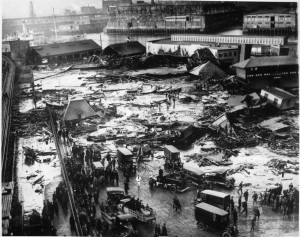 These days, most tsunami waves come with prior warning…at least since the 1946 wave that hit Alaska and Hawaii. Nevertheless, there are disastrous waves that are largely unpredictable, and those can be as deadly as the ones that the Pacific Tsunami Warning System warns people about. One in particular I had never heard of, until my sister Cheryl Masterson heard about it and mentioned it a few days ago. It happened in Boston, Massachusetts on January 15, 1919, and while it was of a very different variety than most tsunamis, it was deadly nevertheless. This tsunami was so strange, in fact, that most people wouldn’t even believe that this is a true story, but it did happen.
These days, most tsunami waves come with prior warning…at least since the 1946 wave that hit Alaska and Hawaii. Nevertheless, there are disastrous waves that are largely unpredictable, and those can be as deadly as the ones that the Pacific Tsunami Warning System warns people about. One in particular I had never heard of, until my sister Cheryl Masterson heard about it and mentioned it a few days ago. It happened in Boston, Massachusetts on January 15, 1919, and while it was of a very different variety than most tsunamis, it was deadly nevertheless. This tsunami was so strange, in fact, that most people wouldn’t even believe that this is a true story, but it did happen.
Around 12:40pm on January 15, 1919, a storage tank holding 2.3 million gallons of molasses exploded at the Purity Distilling Co. in the North End of Boston, sending waves of molasses rushing through the streets at almost 35 miles per hour. I’m sure that many people wouldn’t even think of this event as being at all dangerous, I mean after all, it’s just molasses. Nevertheless, a 25 foot high wave of molasses coming at you going 35 miles per hour is as deadly as being hit be a car. There was no warning, and in reality, there couldn’t  be. The molasses was being stored in the tank awaiting transfer to another plant and, due to its quickly rising temperature, it set off a tragic and previously unheard of chain of events. According to witnesses, the ground shook as if a tornado or freight train were coming down the street.
be. The molasses was being stored in the tank awaiting transfer to another plant and, due to its quickly rising temperature, it set off a tragic and previously unheard of chain of events. According to witnesses, the ground shook as if a tornado or freight train were coming down the street.
According to The Boston Globe, citizens “were picked up by a rush of air and hurled many feet.” A truck itself was picked up by the gushing wave and thrown into Boston Harbor. The force of the wave was so destructive, it almost tipped a railroad car off of Boston’s elevated railway tracks.” And The Boston Post described the gruesome scene, “Molasses, waist deep, covered the street and swirled and bubbled about the wreckage. Here and there struggled a form — whether it was animal or human being was impossible to tell. Horses died like so many flies on sticky fly-paper. The more they struggled, the deeper in the mess they were ensnared. Human beings — men and women — suffered likewise.”
The final death toll was set at 21, while 150 people were injured. The dead were either crushed by debris filled molasses, or drowned by the molasses itself. People and animals were seen struggling, some for which nothing could be done. The clean up was massive. Fire trucks were brought in to hose down the streets, and welders to 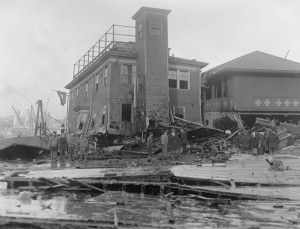 cut the tank up. The harbor was brown until summer. The molasses seeped into every crack, and it is said that on hot summer days, you could smell it for decades. I’m not sure how that could be, but maybe their minds played tricks in them too. In the end, the public outcry made a lawsuit necessary. The townspeople brought a class-action suit against the United States Industrial Alcohol Company, which had recently bought the Purity Distilling Company. Three years of hearings later, the USIAC was found guilty and forced to pay $600,000, which would equate to almost $10 million today, in settlements for negligence. The wave was as deadly as any tsunami could have been, but in reality, no warning could have prevented this tragedy.
cut the tank up. The harbor was brown until summer. The molasses seeped into every crack, and it is said that on hot summer days, you could smell it for decades. I’m not sure how that could be, but maybe their minds played tricks in them too. In the end, the public outcry made a lawsuit necessary. The townspeople brought a class-action suit against the United States Industrial Alcohol Company, which had recently bought the Purity Distilling Company. Three years of hearings later, the USIAC was found guilty and forced to pay $600,000, which would equate to almost $10 million today, in settlements for negligence. The wave was as deadly as any tsunami could have been, but in reality, no warning could have prevented this tragedy.
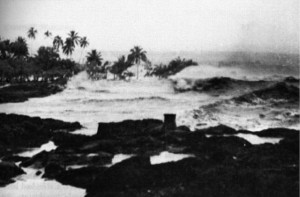 Most of us think of April 1st as April Fools Day…a day recognized all over the world as a day set aside to pull pranks, hoaxes, and practical jokes on your friends neighbors and co-workers. I can remember many pranks pulled by my sisters, my parents, and me over the years. But, not everything that happens on April 1st can be considered a funny joke…as was the case on April 1, 1946, when a 7.4 magnitude earthquake was recorded in the North Pacific Ocean off of Unimak Island. The island is a part of the Aleutian chain in Alaska. When the earthquake struck, in the middle of the night, 13,000 feet beneath the surface of the ocean, a devastating tidal wave immediately hit the nearest land…Unimak Island. The wave estimated at 100 feet high, crashed into a lighthouse located 30 feet above sea level, where a five people lived. The lighthouse was smashed and the people living inside were killed instantly. They had no warning of impending disaster and death.
Most of us think of April 1st as April Fools Day…a day recognized all over the world as a day set aside to pull pranks, hoaxes, and practical jokes on your friends neighbors and co-workers. I can remember many pranks pulled by my sisters, my parents, and me over the years. But, not everything that happens on April 1st can be considered a funny joke…as was the case on April 1, 1946, when a 7.4 magnitude earthquake was recorded in the North Pacific Ocean off of Unimak Island. The island is a part of the Aleutian chain in Alaska. When the earthquake struck, in the middle of the night, 13,000 feet beneath the surface of the ocean, a devastating tidal wave immediately hit the nearest land…Unimak Island. The wave estimated at 100 feet high, crashed into a lighthouse located 30 feet above sea level, where a five people lived. The lighthouse was smashed and the people living inside were killed instantly. They had no warning of impending disaster and death.
The Wave then headed toward Hawaii, at 500 miles an hour. Hawaii was 2,400 miles south of the epicenter. 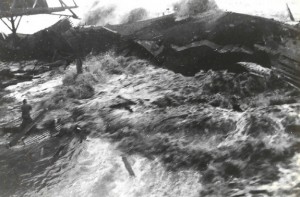 Captain Wickland of the United States Navy spotted the coming wave at about 7am…four and a half hours after the quake. Wickland’s position on the bridge was 46 feet above sea level, and he said he was eye level with a “monster wave” that was two miles long. I can only imagine how he must have felt looking at that wave. The word helpless is the first word to come to my mind. As the wave came into Hilo Bay, the water first receded, leaving ships on the sea floor beside fish flopping in the sand. Then, the tsunami struck full force. The wave was 32 feet high, and it completely destroyed about a third of the city. The Wailuku River bridge was picked up and relocated 300 feet from it’s original position. In Hilo, 96 people lost their lives. Other parts of Hawaii were hit by waves up to 60 feet. In Laupahoehoe, a schoolhouse was crush, killing the teacher and 25 students. The tsunami was seen as far away as Chili, where unusually high waves crashed ashore 18 hours after the earthquake hit. There were no casualties were reported there.
Captain Wickland of the United States Navy spotted the coming wave at about 7am…four and a half hours after the quake. Wickland’s position on the bridge was 46 feet above sea level, and he said he was eye level with a “monster wave” that was two miles long. I can only imagine how he must have felt looking at that wave. The word helpless is the first word to come to my mind. As the wave came into Hilo Bay, the water first receded, leaving ships on the sea floor beside fish flopping in the sand. Then, the tsunami struck full force. The wave was 32 feet high, and it completely destroyed about a third of the city. The Wailuku River bridge was picked up and relocated 300 feet from it’s original position. In Hilo, 96 people lost their lives. Other parts of Hawaii were hit by waves up to 60 feet. In Laupahoehoe, a schoolhouse was crush, killing the teacher and 25 students. The tsunami was seen as far away as Chili, where unusually high waves crashed ashore 18 hours after the earthquake hit. There were no casualties were reported there.
The tsunami brought to light a need for some kind of a warning system. The warning system, called the Seismic SeaWave Warning System was established two years later. It is now known as the Pacific Tsunami  Warning System, and it uses undersea buoys throughout the ocean, along with seismic activity detectors to predict killer waves. The system is still in use, and has warned many people in time to get to safety. Nevertheless, on its first use…November 4, 1952, the people evacuated successfully, but the wave never materialized. I suppose that could have been listed as a successful failure, but in that case, it wasn’t about whether or not the wave came, but rather, if it did, that the people were safely away. A system like this one can’t save everyone. I’m sure that some waves just get to land too quickly, but every life saved matters. The April Fools Day tsunami was on April 1st, but no one would call it a joke… and that’s for sure.
Warning System, and it uses undersea buoys throughout the ocean, along with seismic activity detectors to predict killer waves. The system is still in use, and has warned many people in time to get to safety. Nevertheless, on its first use…November 4, 1952, the people evacuated successfully, but the wave never materialized. I suppose that could have been listed as a successful failure, but in that case, it wasn’t about whether or not the wave came, but rather, if it did, that the people were safely away. A system like this one can’t save everyone. I’m sure that some waves just get to land too quickly, but every life saved matters. The April Fools Day tsunami was on April 1st, but no one would call it a joke… and that’s for sure.
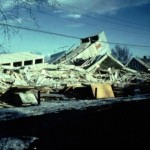
 While my husband, Bob and I were in Anchorage, Alaska recently, we went to the area visitor’s center, where we watched a movie about the 1964 Great Alaska Earthquake that occurred there. It was the largest earthquake in the history of the United States, registering 9.2 on the Richter Scale. The earthquake occurred on March 27, 1964 at 5:36pm, just 5 years after Alaska became the 49th state. It was Good Friday, and a lot of places had closed early for the holiday…a fact credited for savings lives. The death toll was relatively low, at 131…most of whom were killed by the tsunami that followed the quake. That number is amazing when you consider the magnitude of the quake. The property damage, was a very different thing. The main street became two levels. The school split into two sections, homes were leveled, and streets were split down the middle. All that is common in earthquakes…especially of that magnitude, but there were some things that were less common.
While my husband, Bob and I were in Anchorage, Alaska recently, we went to the area visitor’s center, where we watched a movie about the 1964 Great Alaska Earthquake that occurred there. It was the largest earthquake in the history of the United States, registering 9.2 on the Richter Scale. The earthquake occurred on March 27, 1964 at 5:36pm, just 5 years after Alaska became the 49th state. It was Good Friday, and a lot of places had closed early for the holiday…a fact credited for savings lives. The death toll was relatively low, at 131…most of whom were killed by the tsunami that followed the quake. That number is amazing when you consider the magnitude of the quake. The property damage, was a very different thing. The main street became two levels. The school split into two sections, homes were leveled, and streets were split down the middle. All that is common in earthquakes…especially of that magnitude, but there were some things that were less common.
At the Alaska Wildlife Conservation Center, there exists a stand of dead trees. It might make sense to cut these trees down, but it would not be an easy thing to do. The ground dropped 10 feet in the 1964 earthquake, and the influx of salt water from 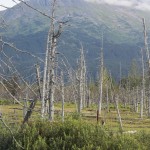
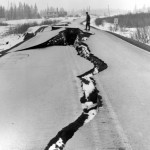 the inlet killed the trees…petrifying them at the same time. To cut the trees down takes approximately 4 hours per tree, and seemed too impossible a job to tackle. The settlement of Portage, Alaska sank six feet, putting it below sea level. The town doesn’t really exist now, except as a ghost town. Everyone has had to relocate to nearby high ground.
the inlet killed the trees…petrifying them at the same time. To cut the trees down takes approximately 4 hours per tree, and seemed too impossible a job to tackle. The settlement of Portage, Alaska sank six feet, putting it below sea level. The town doesn’t really exist now, except as a ghost town. Everyone has had to relocate to nearby high ground.
But the area that hit me the most was an area called Earthquake Park. The four minutes that the earthquake rattled the area caused the Turnagain Heights neighborhood to virtually disappear. I guess the damage to that area is technically a landslide, but it was really more of a wave motion. During those four minutes, the land rolled up and down like a roller coaster. When the quake was over, many of the homes in that neighborhood had been literally swallowed up by the quake. As we looked at the area during our city tour and again as we walked the Tony Knowles Coastal Trail, it felt so strange to me. Our guide told us that if you walked through the land that went uphill and then down hill, just like a wave, you could still see chimneys sticking up out of the ground, where the home that was attached to them had literally disappeared beneath the earth. I simply couldn’t imagine what it must have been like to have the home you 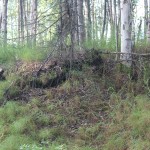
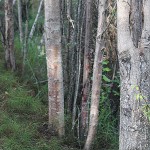 were in, be swallowed up by the earth. I was not able to get any death toll that was specific to the Turnagain Heights area, but with so many people home for the coming holiday, I think there must have been several or even more. It’s hard to describe what I felt in the Earthquake Park area, but I guess it was a mixture of awe and loss. I don’t know how that much devastation could occur on a holiday weekend, with no loss of life. The area felt like you needed to be quiet…as a show of respect maybe. I can’t really say exactly, I just know that it is a place I will not soon forget.
were in, be swallowed up by the earth. I was not able to get any death toll that was specific to the Turnagain Heights area, but with so many people home for the coming holiday, I think there must have been several or even more. It’s hard to describe what I felt in the Earthquake Park area, but I guess it was a mixture of awe and loss. I don’t know how that much devastation could occur on a holiday weekend, with no loss of life. The area felt like you needed to be quiet…as a show of respect maybe. I can’t really say exactly, I just know that it is a place I will not soon forget.
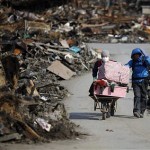 I was watching the news tonight about an American family that had just found out that their daughter was among the casualties of the tragic earthquake and tsunami a little over a week ago. Taylor Anderson, an accomplished English teacher who had been living in Japan and teaching English to young students there, used what precious time she had to escape, to make sure her students were safe. It was a brave and selfless act that cost her her life in the end. She was the first American known to have been killed in the disaster.
I was watching the news tonight about an American family that had just found out that their daughter was among the casualties of the tragic earthquake and tsunami a little over a week ago. Taylor Anderson, an accomplished English teacher who had been living in Japan and teaching English to young students there, used what precious time she had to escape, to make sure her students were safe. It was a brave and selfless act that cost her her life in the end. She was the first American known to have been killed in the disaster.
Losing their daughter was probably the single worst event in the lives of her family, but to add to the tragedy of that loss, is the fact that, as often happens in the aftermath of a disaster, information can get mixed up. Taylor’s family had been told that she had survived and was safe, only to find out later that they had been misinformed. A devastating turn of events. Almost impossible to believe.
I know how this family feels, and my heart goes out to them. My family also experienced a similar devastating situation of misinformation. My Great Aunt Gladys was one of the victims in the 1989 crash of United Airlines flight 232 in Sioux City, Iowa. Our family was also told that she had survived, and it was even on television…but it wasn’t to be. Somehow her purse had arrived at a hospital with another woman, so they thought it was her. We couldn’t believe it, and even continued to watch the reports, hoping against hope that they had been wrong.
to watch the reports, hoping against hope that they had been wrong.
Losing a loved one in any kind of disaster is unbearably hard, but when you are told they made it, and then find out they didn’t…well, it’s like losing them twice. It is no one’s fault, of course, and those people who have told someone their loved one is safe, only to have to tell them they were mistaken, are torn to shreds too. It is devastating to all involved, and my heart goes out to each and every one of them.
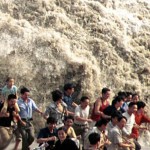 While watching the news concerning the earthquake in Japan, and the ensuing tsunami in Japan, Hawaii, and the US west coast this week, I am once again shocked and saddened by the chances people take. The people is Japan had virtually no warning, and so they couldn’t prepare for the tragic events that happened that awful day, but the man that was swept out to sea in California while taking pictures of the waves, knew the chance he was taking.
While watching the news concerning the earthquake in Japan, and the ensuing tsunami in Japan, Hawaii, and the US west coast this week, I am once again shocked and saddened by the chances people take. The people is Japan had virtually no warning, and so they couldn’t prepare for the tragic events that happened that awful day, but the man that was swept out to sea in California while taking pictures of the waves, knew the chance he was taking.
I’m quite sure that if the people in Japan had been able to get away, they would have. There simply wasn’t time, and as a result, many lives were unavoidably lost. My heart goes out to everyone affected by this tragedy. Those left behind have a monumental job ahead of them to rebuild in the midst of so much grief.
The people in Hawaii and the US west coast, had enough warning, however, and were told to stay away from the coast line. So why do we feel the need to go out there and get pictures of the event, simply to say we were there. My mind wanders to the thoughts going through the mind of that poor man being swept out to sea, knowing that his impending death was due entirely to his own foolish choices. Obviously, if he could do it all over again, knowing what he now knows, he would literally run in the opposite direction. I’m sure he thought of his loved ones toward the end, with much regret for putting them in a position of such grief. I know it was not his intent to end up this way, but the love of the all elusive historic photo to document the day, overtook his good sense concerning his own safety.
As I watched the footage, I saw a wave coming in to a Santa Cruz, California marina, and hitting the boats parked there. People were walking on the docks there! It was unbelievable! The reporter was saying that these people had been told not to be there, but once again the thought that “it won’t happen to me” kicked in and curiosity won out. Even if you aren’t swept away, getting caught between two colliding boats would take the same toll. People, please…think of your loved ones, if you can’t think of yourself. Please don’t take the risk. It isn’t worth it.

